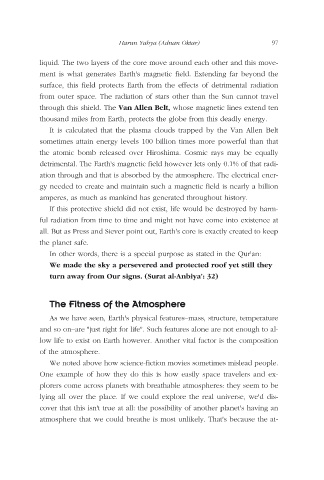Page 99 - The Creation Of The Universe
P. 99
Harun Yahya (Adnan Oktar) 97
liquid. The two layers of the core move around each other and this move-
ment is what generates Earth's magnetic field. Extending far beyond the
surface, this field protects Earth from the effects of detrimental radiation
from outer space. The radiation of stars other than the Sun cannot travel
through this shield. The Van Allen Belt, whose magnetic lines extend ten
thousand miles from Earth, protects the globe from this deadly energy.
It is calculated that the plasma clouds trapped by the Van Allen Belt
sometimes attain energy levels 100 billion times more powerful than that
the atomic bomb released over Hiroshima. Cosmic rays may be equally
detrimental. The Earth's magnetic field however lets only 0.1% of that radi-
ation through and that is absorbed by the atmosphere. The electrical ener-
gy needed to create and maintain such a magnetic field is nearly a billion
amperes, as much as mankind has generated throughout history.
If this protective shield did not exist, life would be destroyed by harm-
ful radiation from time to time and might not have come into existence at
all. But as Press and Siever point out, Earth's core is exactly created to keep
the planet safe.
In other words, there is a special purpose as stated in the Qur'an:
We made the sky a persevered and protected roof yet still they
turn away from Our signs. (Surat al-Anbiya’: 32)
The Fitness of the Atmosphere
As we have seen, Earth's physical features–mass, structure, temperature
and so on–are "just right for life". Such features alone are not enough to al-
low life to exist on Earth however. Another vital factor is the composition
of the atmosphere.
We noted above how science-fiction movies sometimes mislead people.
One example of how they do this is how easily space travelers and ex-
plorers come across planets with breathable atmospheres: they seem to be
lying all over the place. If we could explore the real universe, we'd dis-
cover that this isn't true at all: the possibility of another planet's having an
atmosphere that we could breathe is most unlikely. That's because the at-

